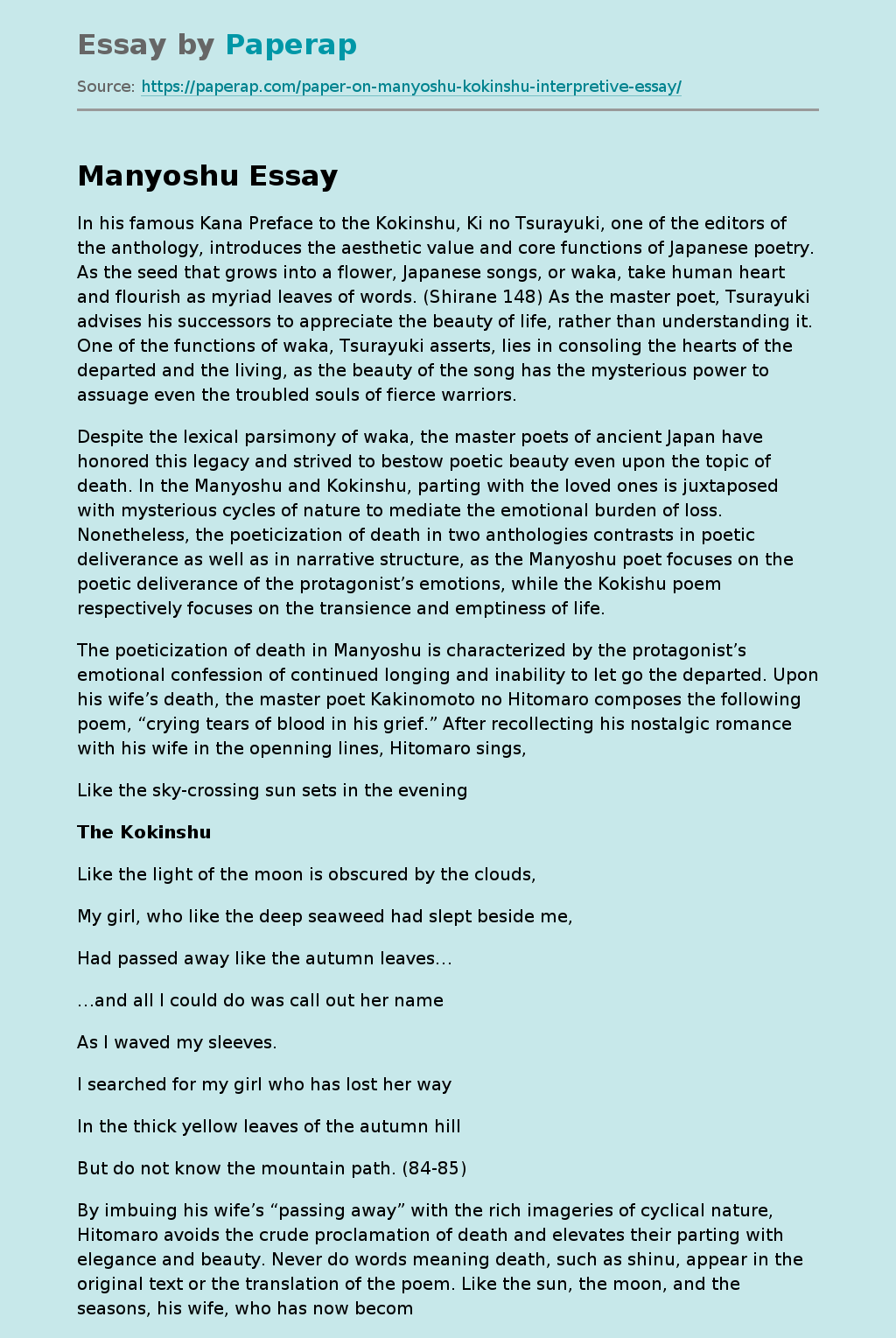In his famous Kana Preface to the Kokinshu, Ki no Tsurayuki, one of the editors of the anthology, introduces the aesthetic value and core functions of Japanese poetry. As the seed that grows into a flower, Japanese songs, or waka, take human heart and flourish as myriad leaves of words. (Shirane 148) As the master poet, Tsurayuki advises his successors to appreciate the beauty of life, rather than understanding it. One of the functions of waka, Tsurayuki asserts, lies in consoling the hearts of the departed and the living, as the beauty of the song has the mysterious power to assuage even the troubled souls of fierce warriors.
Despite the lexical parsimony of waka, the master poets of ancient Japan have honored this legacy and strived to bestow poetic beauty even upon the topic of death. In the Manyoshu and Kokinshu, parting with the loved ones is juxtaposed with mysterious cycles of nature to mediate the emotional burden of loss. Nonetheless, the poeticization of death in two anthologies contrasts in poetic deliverance as well as in narrative structure, as the Manyoshu poet focuses on the poetic deliverance of the protagonist’s emotions, while the Kokishu poem respectively focuses on the transience and emptiness of life.
The poeticization of death in Manyoshu is characterized by the protagonist’s emotional confession of continued longing and inability to let go the departed. Upon his wife’s death, the master poet Kakinomoto no Hitomaro composes the following poem, “crying tears of blood in his grief.” After recollecting his nostalgic romance with his wife in the openning lines, Hitomaro sings,
Like the sky-crossing sun sets in the evening
The Kokinshu
Like the light of the moon is obscured by the clouds,
My girl, who like the deep seaweed had slept beside me,
Had passed away like the autumn leaves…
…and all I could do was call out her name
As I waved my sleeves.
I searched for my girl who has lost her way
In the thick yellow leaves of the autumn hill
But do not know the mountain path. (84-85)
By imbuing his wife’s “passing away” with the rich imageries of cyclical nature, Hitomaro avoids the crude proclamation of death and elevates their parting with elegance and beauty. Never do words meaning death, such as shinu, appear in the original text or the translation of the poem. Like the sun, the moon, and the seasons, his wife, who has now become a fabric of nature, passes away (sugite) from him.
Consequent lines with makurakotoba, catalpa gem and catalpa bow, allow the readers to further relate to and vicariously experience his emotions, amplifying the conveyance of grief. It is also important to note that juxtaposition of the loss and imageries of cyclical nature reflects Hitomaro’s hope for his wife to return, as sun rises again and the autumn returns every year. Later in his short poem, the wife is described as having “lost her way” in the mountain. Despite the mountain symbolizing the insurmountable and unfathomable divide between the two lovers, Hitomaro still yearns for her return believing that he can bring her back if only he had known the mountain path (yamaji shirazu mo). Yet as he cannot venture across the mountain into the forbidden realm, he laments that he can only call out her name and wave his sleeves (sode so furitsuru), a ritual to summon the departed back to life.
An unknown poet of Kokinshu also uses nature as a medium for poeticizing death and conveying emotions of loss. After the Horikawa chancellor died and his remains were interred near Mount Fukakusa, the poet composes in Heian style of lexical parsimony,
Poem #832
If cherry trees indeed
Have feelings, may those
Of the fields of Fukakusa
This year, at least,
Shround themselves in black blossoms. (162)
Unlike Hitomaro, the Kokinshu poet neither confesses his lingering feelings nor hopes for the departed to return. However, through a simple imagery of black, mourning blossoms, instead of an emotional narrative, the poet elegantly conveys the burden of his grief. The waka is almost addressed to the cherry blossoms, as the last line ends in volitional form. Furthermore, the essence of the poem is encapsulated in the word sumizome of the cherry blossoms. As if to prepare them for the burial, the poet invokes the cherry blossoms to bloom in “dyed black (sumizome ni sake).” The word also reminds the reader the word sumu, meaning “to live.” The prosopopoeia is further intensified by the use of the word, kokoro. Although it is translated as “feelings” in the text, it may also be read as “heart”or “soul.” The poet’s impossible demand for the cherry blossoms not only reflects his remorse, but also informs the reader of the transience and emptiness of life. As one cannot suppress the promised beauty of the cherry blossoms, one can never escape the passing of life.
As Tsurayuki opined in his Kana Preface, the cares and deeds of men and women are endless. Yet there is an end to each and every man and woman and the ancient Japanese poets continued to find beauty in death through their myriad leaves of words. Though the autumn leaves will surely fall, the promised mists of spring will come and the fair hills of Yoshino will be adorned, once again, with cherry blossoms. Likewise, though the departed will go across the “mountain path” and the living will be in “dyed black,” the songs will live on until the end of time, shedding light into the Japanese heart of kokoro.
Kana Preface of Kokinshu. (2019, Dec 05). Retrieved from https://paperap.com/paper-on-manyoshu-kokinshu-interpretive-essay/

